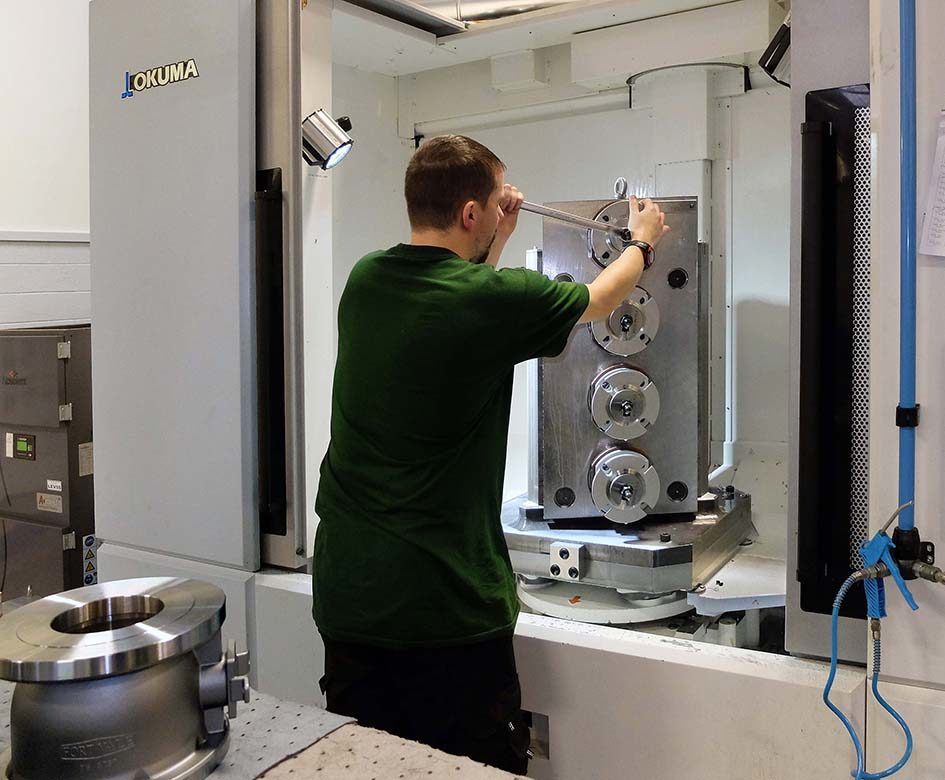Ted Fort OBE, who has recently become an octogenarian, started buying Okuma machining centres and lathes more than 40 years ago for his company, Fort Vale Engineering. It is now global market leader for the manufacture of stainless steel valves and ancillaries used in the tank container industry for transportation of bulk liquids and gases by road, rail and sea. An ex Rolls-Royce engineer and Chairman of his company, he recently stated, “Machine tools are our artillery and we always buy the best, without exception.”
Andrew Bryce, the company’s Innovation Director who joined as a machinist in the late 1980s, continues to buy Japanese-built Okuma machines from UK agent, NCMT. One-fifth of the 40 CNC machine tools in the Burnley factory are currently from that source.
Most recently, in November 2016, he purchased an MA600 horizontal machining centre with the ability to turn-cut, Okuma’s terminology for interpolation turning. Circular movement of the machine’s X and Y axes coupled with synchronous rotation of a turning tool in the spindle and forward feed in Z can execute either internal boring or external turning that can include complex features.

The Okuma MA600 horizontal machining centre in use at Fort Vale Engineering, Burnley.
Andrew commented, “We particularly like Okuma horizontal machining centres (HMCs), as overall their technology leads the field and their OSP control is a big advantage for us.
“As the manufacturer produces its own CNC system, as well as the spindle, drives, rotary encoders and scales, the control’s functionality is matched to the machine, allowing perfect synchronisation during the turn-cut process. When we started to evaluate our next HMC purchase, the Okuma solution with turn-cut from NCMT was the obvious choice, as other machine platforms offering interpolation turning could not match its performance.”
To emphasise the point, he asked process improvement engineer Stephen Maher to compare the performance of the OSP200 control on an earlier Okuma MA500 HMC with the OSP-P300MA and turn-cut software on the latest machining centre.
Stephen said, “Interpolation turning is an extremely useful addition. Previously, when producing a newly designed component with a stepped cross bore containing radii, counterbores and chamfers, to generate that single profile we had to specify and purchase up to six special form cutters and they could take typically up to six weeks to arrive.
“Now, with turn-cut, we can produce the part immediately. One roughing and one finishing boring bar with indexable inserts does the same work, saving on expensive cutters as well as shortening programming and cycle times. It also significantly compresses lead-time from concept to finish component.”
Production Co-ordinator Carl Tillotson likes the ergonomic position of the control on the latest machine. It ensures he does not have to look over his shoulder when proving out jobs. Additionally, he pointed out the OSP-P300MA’s extra features, such as allowing the operator to customise the touch-screen layout to show different page functions at the same time.
Carl went on to say that the construction of the MA600 is “really sturdy” and that every job transferred from the older MA500 has shown a cycle time improvement of around one-third using the identical program. For example, six parts on a tombstone can be completed in 20 rather than 30 minutes.
All tooling now runs at the manufacturer’s recommended speeds and feeds due to the machine’s rigidity. The service life of each cutter is longer and more predictable, assisted by the 70 bar coolant system and efficient swarf ejection, even though 316 and 304 stainless steels are being machined nearly all the time.
Accuracy of profiled bore details by finish turn-cutting is much better than when using form tools and there are no sharp transitions between features. Tolerances down to 10 microns are held and surface finish is high at 0.4 Ra, crucial to ensure that there are no leak paths in the valves.
Due to the success of the turn-cut feature, the production team at Fort Vale Engineering is now looking at extending its use to threading and eccentric boring to replace turning and milling. Machining of scrolls on valve sealing faces instead of turning them may also be included.
Andrew Bryce summarised, “The technique is helping us to innovate and stay ahead of our competitors through shorter lead-times in programming, tooling acquisition and cycle times. It is therefore allowing us to achieve one of our prime objectives, namely faster deliveries to customers.”







